
|
Credit: Galileo Project,
NASA
Explanation:
Tonight, those blessed with clear skies can enjoy a
glorious full moon,
the last full moon of the "Y1.9K"s.
In fact, tonight's moon will be a full-perigee-solstice moon,
reaching its full phase and perigee (the closest point in
its orbit)
on the solstice,
the first day of northern hemisphere winter.
Anticipation of this celestial event has generated
a flood of e-mail chasing the rumor
that the full-perigee-solstice moon will be intensely bright.
However, calculations show it will only be a little brighter than usual,
and certainly not dramatically so.
Why would it be brighter?
Mostly because the moon appears bigger and brighter at perigee.
The above illustration, based on
Galileo spacecraft images,
shows the approximate difference in apparent
size between a
full moon
at perigee (left) and a full moon at apogee,
the farthest point in the lunar orbit.
The Earth and moon are also a few percent closer to the sun
during northern winter,
but the combined effects will cause tonight's full moon to appear
only about 20% brighter than an average full moon.
That difference is not even likely to be noticeable to
the human eye.
|
January February March April May June July August September October November December |
| ||||||||||||||||||||||||||||||||||||||||||||||||
NASA Web Site Statements, Warnings, and Disclaimers
NASA Official: Jay Norris. Specific rights apply.
A service of: LHEA at NASA / GSFC
& Michigan Tech. U.
Based on Astronomy Picture
Of the Day
Publications with keywords: solstice - perigee - apogee - full moon - Moon
Publications with words: solstice - perigee - apogee - full moon - Moon
See also:
